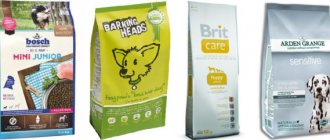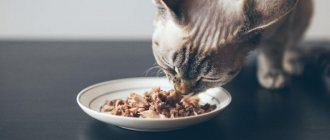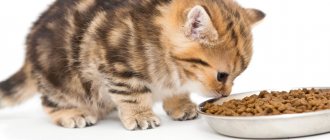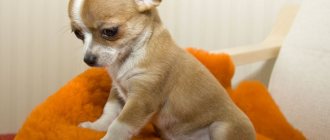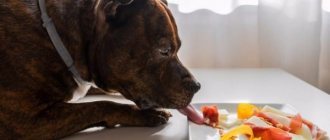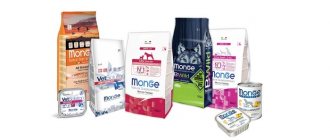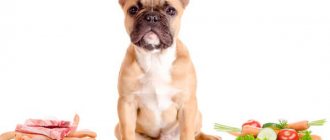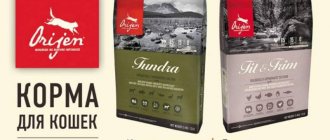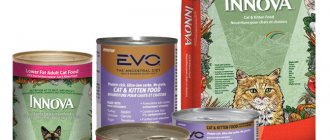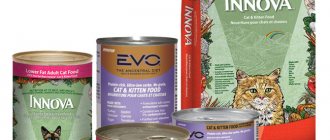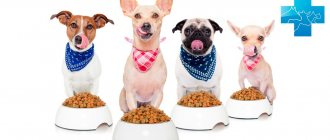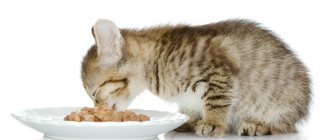Properly selected dry food for kittens is the key to the health and development of a pet, regardless of gender, age and breed (be it Scottish Fold, Maine Coon, Sphynx, Bengal, etc.). Newborn animals refuse mother's milk and switch to adult food at about 2 months. By this time, caring owners should create a diet that will be beneficial and not harmful.
Rating of the best dry food for kittens
From the author: almost all food, even high-end ones, contain rice or potatoes, and sometimes both, as a carbohydrate component. In general, this is not so bad, especially when the manufacturer specifies that it is yam (sweet potato), whole brown or white rice. True, the use of the latter is preferable, and the best feeds add vegetables as carbohydrates. Cereals, such as corn or wheat gluten, flour from these products, etc., are highly not recommended for cats and kittens. should alert the owner.
List of the best solid foods for pets up to a year old (you can click on the photo of the composition to enlarge it):
| Name | Description, composition on packaging, granules |
| Orijen Cat & Kitten | Made in Canada. Considered the best holistic practitioner. There are no grains, potatoes, or rice. 85% are sources of protein, 15% are carbohydrates. The first ones used are fresh chicken, turkey, fish, and offal. The second are red and green lentils, green and yellow peas, chickpeas, beans, whole navy beans, pumpkin, etc. Calorie content: 416 kcal per 100 g. Feed costs from 800 to 1500 rubles. per kg depending on packaging. |
| Applaws Kitten Chicken Grain Free | Made in the UK. The manufacturer lists potatoes in third place in the composition, but we still put this food in second place, since the first places indicate 62% chicken meat and 17% minced chicken meat (note, not minced chicken, which could mean that there is a lot of skin there). Calorie content: 380 kcal per 100 g. The food has a fairly reasonable price; it costs almost twice as much as Orijen, namely about 420 rubles. per kg when purchasing the largest package. |
| Meowing Heads Smitten Kitten for kittens with chicken and rice | Another British product. Has earned popularity among breeders of elite cat breeds. Contains 70% chicken, fish and eggs, brown rice, oats. Calorie content: 408 Kcal per 100 g. The food contains no additives that can provoke an allergic reaction (corn, dyes, etc.). The price of the products is high, but the quality matches it, namely about 950-1000 rubles. per kg. |
| Canagan Free-Run Chicken, Scottish Salmon, Country Game Canagan Free-Run Chicken Canagan Scottish Salmon Canagan Country Game | The food has not yet received great popularity, because... British manufacturer has recently entered the market. There is no special line for kittens because the diet is suitable for all ages. There are no grains in the composition, they are replaced by potatoes. It is worth noting that if potatoes or sweet potatoes (sweet new ones) are among the first 5 ingredients, as in this food, it is believed that the manufacturer is using it more as a cheap filler rather than a source of fiber that kittens need. However, the rest of the food composition is not bad. Here are the first components of the chicken flavor: chicken meal occupies 35.5%, fresh boneless chicken fillet 25%, followed by sweet potatoes and potatoes, 4.2% chicken fat, 4% eggs, 2.3% chicken broth, 1. 2% salmon oil, minerals, vitamins, etc. The feed is 90% digestible, thanks to this there will be a minimal amount of excrement. Calorie content is not indicated by the manufacturer. It is more profitable to take large packages weighing 4 kg, then the food will cost from 850 to 950 rubles. per kg, otherwise it will cost more than 1000 rubles.
|
| Grandorf Lamb & Rice Kitten | Country of origin: Belgium. There is only one type available for kittens. The products contain a large amount of proteins, are hypoallergenic, strengthen the immune system, and relieve problems with hair and teeth. Unfortunately, the manufacturer does not specify the percentage of protein components. But dehydrated lamb and turkey come in first and second place, and whole white rice comes in third. Calorie content: 449 kcal per 100 g. When purchasing a two-kilogram package, a kg of feed will cost 750 rubles. |
| Pronature Holistic Kitten Chicken & Sweet Potato | Feed made in Canada. Instead of wheat, it contains rice and sweet potatoes. At the beginning are whole and dehydrated chicken, 19% each, chicken fat and herring flour. Calorie content: 424 kcal per 100 g. A kg of feed when purchasing the largest package will cost from 700 to 750 rubles. |
| Farmina N&D Kitten Chicken & Pomegranate Grain Free | The food is produced in Italy and Serbia. It consists of 70% protein, and 30% vegetables and fruits. In third place in the composition is potatoes after 30% fresh boneless chicken and 28% dehydrated. Product absorption occurs at 80-90%. Calorie content: 393 kcal per 100 g. Feed per kg when buying a large package will cost from 600 to 800 rubles, if you buy a small one, 1.5 kg, then 1000 rubles. |
| 1st Choice Kitten Healthy Start Chicken | The food is produced in Canada. In third place in the composition is rice, and the manufacturer does not specify which one, which makes us wary. But in any case, it is better than cereals. In first and second place are 17% fresh chicken and the same amount of flour from this bird. Calorie content: 376.2 kcal per 100 g. Buying a 5 kg package of food will cost about 630 rubles. per kg. |
| Fitmin Cat Purity Kitten | Czech manufacturer. There are some questions about the composition, the meat is indicated at the beginning, of which 44% chicken, 19% pork liver, 8% duck, 5.6% fish, 1.7% pork and beef. It is not clear what kind of meat takes up another 21.7%. Next comes chicken fat. Farm potatoes and green peas are used as the main carbohydrates. The composition includes substances that eliminate the unpleasant odor of excrement. Calorie content: 430 kcal per 100 g. The food costs 580 rubles. per kg when purchasing a package of 10 kg. 850-1000 rubles if you buy a small one. |
| Brit Care Crazy I'm Kitten | Manufacturer from the Czech Republic. The ingredients include rice and rice bran in third and fifth place respectively. It is a pity that the manufacturer does not specify what kind of rice is used. In first place are high-quality sources of protein, 25% dehydrated chicken and 22% fillet, in fourth place is chicken fat. In general, the food is quite suitable for feeding kittens. But one of the reviews that we analyzed indicated that, judging by the taste, the granules contain corn, which the manufacturer does not mention. Believe it or not, it's up to you. You can try the food and then watch your pet’s reaction. It is also worth considering that this food is not suitable for all animals. Some pets refuse it and lose weight because of this. Therefore, before completely switching to it, you need to test it for a few weeks first. This composition is unpopular with many breeders due to its low taste and low nutritional value. Calorie content: 440 kcal per 100 g. The food is not very expensive, from 400-450 rubles. per kg when purchasing a package of 7 kg. |
| Karmy Kitten Turkey | Not a bad composition for premium food. These are domestic products. The range is constantly expanding, which indicates its demand. The composition is well balanced, containing seaweed and vitamin E. There are also elements that block the unpleasant odor of feces. 41% is turkey meat, whole white and brown rice are used as carbohydrates. There is a lack of some macro- and microelements necessary for each kitten individually. Therefore, the veterinarian may prescribe additional vitamin and mineral complexes. The food has a mild aroma, which makes storage easy. But many people talk about the inconvenience of packaging. Calorie content: 408 kcal per 100 g. The food will cost only 380 rubles. per kg when purchasing a package of 10 kg. But even if you buy a small one, 1.5 kg, it will cost from 500 to 550 rubles, which is quite acceptable. |
| Probalance Kitten 1st Diet | We will put this food in last place in our rating. Overall, for a premium product its composition is not that bad. In any case, it is much better than Royal Canin, which we will talk about below. The food is produced by a Danish company. There are also factories in Russia. In first place with 32% poultry meat, followed by rice, barley, beet pulp, oats, and peas. There are a lot of carbohydrates, but they are not the worst. So, barley is the best of all grains in finished feed, of course, we could do without it, but its use is preferable to wheat, corn, rye and even oats. Beet pulp is a good source of fiber, oats, as we have already said, are better than other grains, and peas are also a good ingredient. However, 32% of the bird is not enough for a growing kitten, and it is not specified what kind of bird it is, and it is also not clear what kind of rice is used. So consult your veterinarian before switching your kitten to this food. Calorie content: 385 kcal per 100 g. The price of food is not at all high, a kg will cost only 185 rubles. when purchasing a large package. |
You should not skimp on pet food. Especially on food for kittens, whose bodies are still developing. The health of the animal depends on a properly selected diet. In addition, expensive food is more nutritious; less quantity is needed to keep your pet satisfied. Along with the dry diet, you can also give canned food for kittens.
Is it possible for dogs
Dog food is absolutely not suitable for cats. The physiology of these animals varies greatly; nutrition is selected in accordance with the needs of each species.
Dog food contains an insufficient amount of proteins and fatty acids for cats, the amino acid taurine (the dog’s body synthesizes it independently), and eggs. But there are grains that are harmful to cats.
Proper feeding of a dog is significantly different from feeding a cat!
The consequences of eating dog food in cats are:
- joint diseases;
- urolithiasis disease;
- blurred vision;
- cystitis;
- digestive disorders.
If animals of different species live in the same house, cat feeders should be placed on elevated areas where “neighbors” cannot reach. Cats will have to be monitored to ensure they do not eat from dog bowls.
Dry food for kittens that we do not recommend for daily feeding
| Name | Description |
| Hill's Science Plan Healthy Development | The composition is not the worst, there is quite a lot of high-quality protein, namely chicken and turkey flour. But in third place is corn. Corn protein is even less digestible by cats than wheat protein, only 54%. Moreover, pets get only 20-35% of their energy from carbohydrates; they get more than 40% of it from proteins. Therefore, corn should definitely not be the basis of a cat or kitten’s diet. |
| Josera Kitten | The composition, in addition to duck and turkey flour and duck fat, contains corn, rice and corn gluten. |
| Purina One for kittens | The composition is far from ideal. True, 17% chicken comes first, but even here we cannot be sure that this is meat, because... no specifications, followed by dried poultry protein, 14% whole wheat, animal fat, wheat and corn gluten, soy flour, pea protein concentrate, corn starch, dried chicory root, corn, etc. There is also no information on the percentage of components. |
| ProPlan Junior and Kitten | Contains corn and wheat gluten, rice, corn. In first and second place are 20% chicken and dried poultry protein. |
| Royal Canin | After the food was bought by the Mars company and it began to be produced in Russia instead of France, its quality dropped significantly. In other words, its composition is now very similar to economy, despite the presence of different lines, for example, for kittens there is a special milk replacer, food from 1 to 4 months, from 4 months to a year and for sterilized small cats. For example, the first ingredients in MOTHER&BABYCAT food are: dehydrated animal proteins (poultry), animal fats, rice, vegetable protein isolate, grain flour. So, nowhere is there any clarification about what kind of poultry is used, whether it is meat, what kind of rice, what vegetable protein is obtained from, what kind of grain. In general, the composition leaves much to be desired. |
| Cat Chow Kitten | The food is popular due to its affordable price. Reviews from cat owners are mostly positive, however, there are cases where the products provoked an allergic reaction. The composition contains a minimal amount of vitamins and minerals, so the kitten receives few useful elements. In addition, cereals come first. The diet does not contain harmful chemicals, dyes, or artificial flavors, so this is one of the best options among the economy segment, but you should not feed it on an ongoing basis. |
| Whiskas for kittens delicious pads with milk, turkey and carrots | Is a budget option. In the first place in the composition are wheat flour, poultry meal, turkey meal, meat and bone meal, rice, protein plant extracts, etc. The food cannot be used for daily feeding. |
Is it worth it at all?
The debate about what to feed a cat, dry food or natural food, has been going on for decades. When choosing the option that suits you, you need to consider:
- cat's food preferences;
- pet's health status;
- breeds;
- the degree of employment of the owners.
Advice! If your cat categorically refuses to eat crackers, but loves home-cooked food, you should meet her halfway.
There are few such individuals. Most cats, for example breeds such as the Pixie-Bob or the Japanese Bobtail, are happy to switch to drying. This feeding option is primarily convenient for owners who are busy at work. The finished product does not require time to prepare and does not spoil for a long time.
“Drying” is ideal for novice owners, since it does not require skills in preparing a complete cat diet. It contains all the vitamins and microelements the pet needs (with the exception of economy class food). The cat is not picky about eating vegetables, fruits, and herbs.
Eating “crackers” cats lose interest in natural food. They most likely will not pick up pieces on the street or eat mice or birds. This will significantly reduce the likelihood of poisoning.
Types of dry food
It is very convenient to feed pets with dry food. It saves time, does not require special storage conditions and additional mineral and vitamin complexes. The food is completely balanced, kittens receive all the necessary substances from it. However, not all ready-made diets available on store shelves are of high quality. It is not recommended to feed cats of any age with advertised, cheap products. It contains ingredients of dubious quality.
All cat food is divided into classes:
- Holistics are the best choice for small pets, sterilized cats, and weakened animals. They consist only of high-quality natural ingredients suitable even for human nutrition. The composition includes a huge amount of minerals and vitamins, beneficial plant components.
- Super premium - slightly inferior in composition to the previous type of food, but suitable for kittens.
- Premium - cheaper than holistic products and super premium products. Accordingly, the quality of raw materials is lower. This food can be fed to kittens, but not daily.
- Economy - not recommended for consumption. Such diets consist of low-quality by-products, cheap cereal additives, artificial flavor enhancers and other elements harmful to the growing body.
Diets are divided depending on the age of the kitten:
- up to 12 weeks;
- up to 10 months (for some manufacturers up to 1 year).
Although kittens can start eating a full diet at two months of age, experts recommend feeding dry food starting at 8 months unless there is a particular need for it.
Access to water
While wet food already contains a significant amount of liquid, dry food has virtually none. Therefore, it is extremely important to ensure that your kitten gets enough water intake. Otherwise, he may face kidney and bladder diseases in the future.
The water must be fresh and clean, drinking quality - the same as that used for all family members. It should be poured into a bowl that is comfortable for the kitten. Glass, porcelain and stainless steel are preferable to plastic: cats are sometimes put off by the strong smell of plastic.
The place where you leave the container with the drink is also important: ideally, it should be at least 50 cm away from the food bowl and tray. If you have a spacious home, place bowls of water in two or more rooms - this way your baby, busy playing and learning about the world around him, will be more likely to remember water.
When the kitten drinks, saliva and food debris get into the bowl. The water quickly becomes cloudy and loses its attractiveness in the eyes of the animal, so do not be lazy to change it more often. You should not allow an older cat to drink from the toilet: there may be pathogens and detergent residues there.
Mr. Cat recommends: the benefits of dry food for kittens
Such products have the following advantages:
- simplicity and ease of use and storage;
- availability (can be purchased at any pet store, online);
- balanced composition (of course, you can independently calculate the proportion of substances necessary for a growing kitten, but it’s easier to purchase dry products);
- the content of a beneficial amino acid - taurine, which enters the body only with food (it is not produced naturally; with its deficiency, problems with the activity of the brain and heart begin, and vision deteriorates).
Is drying only allowed?
High-quality dry food is developed in such a way that it is a source of all the substances a cat needs. Therefore, it is even good to feed your pet exclusively with this product, provided that the food is of high quality.
Warning! You should not give only “drying” to cats that drink little water. This can lead to diseases of the urinary system!
To ensure that the product you are purchasing is complete, you need to carefully examine the packaging. Such feeds are marked “complete feed”. If it exists, adding anything to the cat’s food is even harmful. The introduction of other types of food can upset the balance of components in the pet’s body, provoke disturbances in the functioning of the gastrointestinal tract, and exacerbation of chronic pathologies.
Dog food
What are the consequences of violations?
Proper nutrition is the basis for the health and longevity of a domestic cat. Eating disorders can cause serious illnesses.
Among them:
- diabetes;
- allergy;
- gastritis;
- pathologies of the liver, kidneys, pancreas;
- cardiovascular diseases;
- stomach ulcer;
- urolithiasis disease;
- tartar, caries.
With an incorrect diet or constant consumption of economy class food, cats develop vitamin deficiency. Lack of vitamins is especially dangerous:
- E (tocopherol) – leads to deterioration of hair, pathological changes in muscles, infertility;
- C – weakens the immune system, provokes dental problems;
- D – leads to developmental delay, musculoskeletal disorders, rickets;
- A – is fraught with deterioration of vision, disturbances in the functioning of the reproductive and respiratory systems;
- B – causes weakness, alopecia, loss of functionality of the musculoskeletal system.
Most diseases in cats are accompanied by a deterioration in appetite, so there is no need to immediately change food. First, you should consult a veterinarian and begin treatment in a timely manner.
Is it possible different
You cannot mix food from different manufacturers. They may have a different balance of nutritional components, which can cause digestive disorders. It is permissible to combine products of different brands only when transferring a cat from one type of “drying” to another.
Wet food and dry food from the same manufacturer are quite compatible. Veterinarians advise this way to diversify the diet of cats with poor appetite, when the pet is in a weakened condition (after illness, surgery, etc.), or with dental problems. You can combine feed in several ways:
• give wet pieces in the morning, after 4 hours put a bowl with granules, at night - only water and special grass; • one day - wet food 4 times, the next - dry food 2 times. This option is especially good for cats with dental problems. If the cat cannot chew hard granules, they can be soaked in water to a pasty consistency and fed through a syringe without a needle in small portions every 3 hours.
Dangerous! Mixing dry and wet food in one meal is prohibited!
It is not recommended to feed a cat only spiders, since they are digested very quickly, the pet experiences hunger and begins to overeat. In addition, wet, soft pieces get stuck between the teeth, rot, and provoke inflammatory processes in the oral cavity.
You can’t combine “drying” with natural products either. The processes of digestion of these two types of food are very different: both in the time of absorption and in the composition of the necessary enzymes. With constant feeding in this way, a cat may develop gastrointestinal diseases, but sometimes it is permissible to treat a pet “on drying” to beef or turkey. Some breeders develop proprietary mixed diets. It is better not for a person without sufficient experience and knowledge to conduct such experiments on cats.
What not to do
Inexperienced owners of furry predators, even when purchasing the highest quality “drying” for their pets, make serious mistakes that negatively affect the cat’s health.
When feeding a cat with dry food, the following is prohibited:
- replace water with milk. The body of an adult animal does not digest lactose;
- overfeed;
- add “crackers” to natural food (or pouches to granules) to improve appetite;
- offer expired products;
- strive to diversify your diet. Cats are conservative animals. They do not need a variety of dishes, and constant changes cause them digestive disorders;
- give kitten food to adults and vice versa.
You can't suddenly change your diet. Even one-time, deciding to please your pet with an expensive product after receiving a bonus. All changes should occur smoothly, gradually, as comfortably as possible for the cat.
You must follow a diet
Can I eat from my own table?
Food from the human table is absolutely not suitable for a cat, regardless of the type of feeding chosen. Not only is it not beneficial, but it can also be poisonous to your pet.
Particularly dangerous for predators:
- fried, fatty foods;
- chocolate;
- spices;
- pickles;
- cakes and pastries with butter cream;
- marinades;
- sauces;
- mushrooms;
- nuts.
Dangerous! Even a small amount of such food can provoke irreversible changes in the cat’s liver, kidneys, pancreas, and gastrointestinal tract. Combining junk food with dry food will create even more stress on your pet's digestive tract.
